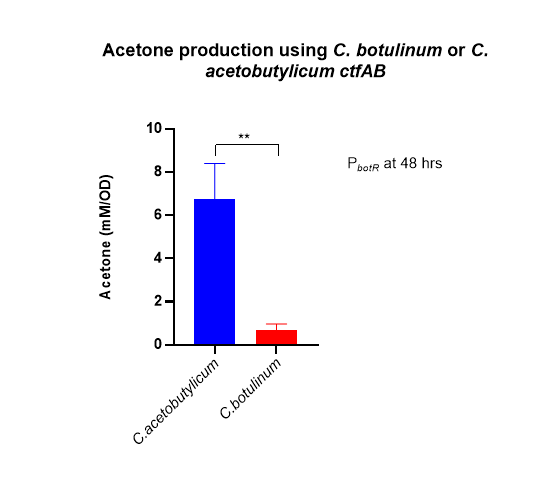Part:BBa_K2992028
Acetone pathway: ca_thl -cb_ctfAB-ca_adc-cpa_Tfdx
Promoterless Botulinum toxin-predicting acetone production pathway pathway with C. acetobutylicum thl and adc with C. botulinum ctfAB
Usage and Biology
This parts entry represents a promoterless acetone-production pathway for plasmid-borne expression in C. sporogenes. The entry comprises the thiolase gene thl BBa_K2992008 and acetoacetate decarboxylase adc gene of C. acetobutylicum BBa_M36587 coupled with the two units of the ctfAB complex from C. botulinum BBa_K2992003 and BBa_K2992005 separated by their native intergenic region containing a partial RBS sequence for ctfB BBa_K2992007. Transcriptional termination for this synthetic acetone-production operon occurs through the activity of Tfdx from C. pasteurianum K2284012 BBa_K2284012. In our project we used genome-scale modelling to predict the necessary genes required to produce acetone in our chosen surrogate strain C. sporogenes. We sought to link acetone production with C. botulinum neurotoxin production by the integration of the neurotoxin transcriptional regulator botR onto the chromosome of C. sporogenes and by using promoter regions from the regulon of botR to control the acetone-production operons. In doing so, we hoped to generate our surrogate host strain as a model for predicting neurotoxin production in foodstuffs following food manufacturing processes.
Characterisation
Before assessing the ability of our chosen acetone production pathways to generate acetone in our C. sporogenes reporter strains, we first assessed promoter activity using our FAST reporter BBa_K2992002. We compared promoter activities of our chosen promoters PbotR BBa_K2992012 and PntnH BBa_K2992001 alongside three constitutive clostridial promoters Pfdxc114t BBa_K2992016, Pfdxt114c BBa_ K2715011 and Pthl BBa_ K2715010 and the E. coli promoter J23106 BBa_ J23106. The plasmids were cloned upstream of the FAST reporter gene and ligated into pMTL82151 plasmids. FAST reporter assays were conducted on both E. coli and C. sporogenes lysates following transfer of genetic material thereto.

In the C. sporogenes experiments, adequate expression was detected for each of the clostridial promoters chosen for study. The two Pfdx derivatives generated the greatest level of reporter activity whilst the two C. botulinum promoters generated much lower levels of activity. Reporter activity appeared to be generally higher when analysed from the E. coli lysates as opposed to the C. sporogenes lysates. In those experiments, activity from the PbotR and Pntnh constructs were considerably greater than the no promoter control.
Having established the functionality of our chosen promoters. We next assessed the feasibility of using these to drive acetone production in our reporter strains. In our design approach, we rationalized that either C. botulinum BBa_K2992003 BBa_K2992007 BBa_K2992005 or C. acetobutylicum-derived ctfAB [BBa_M36581. BBa_M36582, encoding the A and B subunits of the butyrate-acetoacetate CoA-transferase complex, should permit acetone production. To test this, we transformed pMTL82151 plasmids encoding our acetone pathways using C. botulinum ctfAB BBa_K2992029 or C. acetobutylicum ctfAB BBa_K2992036, both under the control of PntnH, into our PbotR-botR reporter strain of C. sporogenes.

The data clearly indicates that ctfAB from C. acetobutylicum was much better suited to providing acetone production capacity to our C. sporogenes reporter strains. These data have provided clear insight into the design strategy for any future exploits of our reporter strains for using acetone production as a model for safely predicting Botulinum neurotoxin production in foodstuffs.
Sequence and Features
- 10INCOMPATIBLE WITH RFC[10]Illegal XbaI site found at 355
Illegal PstI site found at 3250 - 12INCOMPATIBLE WITH RFC[12]Illegal PstI site found at 3250
- 21COMPATIBLE WITH RFC[21]
- 23INCOMPATIBLE WITH RFC[23]Illegal XbaI site found at 355
Illegal PstI site found at 3250 - 25INCOMPATIBLE WITH RFC[25]Illegal XbaI site found at 355
Illegal PstI site found at 3250 - 1000COMPATIBLE WITH RFC[1000]
References
Cornillot, E., Croux, C. and Soucaille, P. (1997). Physical and genetic map of the Clostridium acetobutylicum ATCC 824 chromosome. Journal of Bacteriology, 179(23), pp.7426-7434.
Heap, J., Pennington, O., Cartman, S. and Minton, N. (2009). A modular system for Clostridium shuttle plasmids. Journal of Microbiological Methods, 78(1), pp.79-85.
| None |
